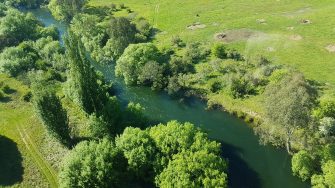
Date: Friday, October 26, 2018
Project: Eastern Australian Waterbird Survey
Observer: John Porter
Another day of clear blue skies almost no wind beckons us out of Wangaratta and we start by counting along the King, Ovens and Kiewa river valleys – the rivers are all running quickly, bolstered by spring meltwaters and in some cases releases of environmental water. The grazing and dairying country below us is green and the pastures have luxuriant grass cover. We encounter low to moderate numbers of Wood duck, Black duck, Straw necked ibis and Spoonbills, especially on the small lagoons and billabo ngs with still water that dot these floodplains.
The Ovens River and emerald green floodplain pasture (Photo: John Porter)
Continuing our survey we move east to the Kiewa river valley and count along the fast flowing Mitta Mitta River – popular with kayakers and canoers because of the rapids and fast flowing water – especially when water is being released from the dam as it is today. As we fly upstream the valley narrows and the floodplain recedes until we are just counting along the channel. There are very few waterbirds in this section of the river – it is too fast and cold to be productive for waterbirds.
Fast flowing and cold – the Mitta Mitta River in Victoria rarely has many waterbirds (Photo: John Porter)
We continue up into the upper reaches of the Mitta Mitta and then survey Banimboola Pondage and Dartmouth Dam at its headwaters – there is a release of water in progress from the pondage which helps to explain the volume of water flowing down the river. Dartmouth dam is popular with recreational fishers and is stocked with introduced trout by the Victorian Department of Primary Industries.
A summer release of water from Dartmouth Dam Regulating Pond or Banimboola Pondage just below Dartmouth Dam – the water flows down the Mitta Mitta and eventually into the Murray River (Photo: John Porter)
Unusually calm conditions on Dartmouth Dam – deep and rarely supporting many waterbirds – we see more fishing boats than waterbirds on the dam today (Photo: John Porter)
After Dartmouth Dam it’s a full power climb to gain altitude and fly up to the the main range of the snowy mountains. Wind and turbulence increases as we bounce our way over the mountains. The red dot of Cootapatamba hut is clearly visible as we pass Mt Kosciuzko.
The main range with the last few drifts of winter snow and the summit road on Mt Kosciuzko visible in the foreground (Photo: Terry Korn)
Our next stop is Lake Jindabyne where we can see environmental water being released into the Snowy River – the snowy white spray is a spectacular sight. The lake itself has few waterbirds – mainly Silver gulls and a few cormorants. Some parts of the shoreline have sandy beaches and a few cattle have wandered down to lie on the warm sand – a comical sight!
Environmental water being released from Lake Jindabyne into the Snowy River (Photo: Terry Korn)
Counting over Lake Jindabyne (Photo: John Porter)
Continuing eastward to the Monaro tablelands we can see just how dry the landscape is, brown and parched grazing land with almost no green in sight, quite a contrast to the lush valley of this mornings counting. There are numerous shallow wetlands on the Monaro which can support large numbers of waterbirds when filled; today however we struggle to find any water. Our last wetland in this leg is a recently constructed reservoir south of Nimmitabel where we find only a few birds. On that note we complete the last leg of the 36th Eastern Australian Waterbird & Wetland Survey and head back to base.
Wind turbines and dry wetlands on the Monaro tablelands west of Nimmitabel in southern NSW (Photo: Terry Korn)
